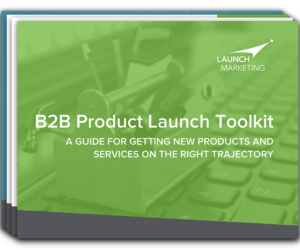
Developing a go-to-market strategy is critical to the success of your organization. Your go-to-market strategy brings together the key elements that drive your business. It provides a strategic action plan that clarifies how to reach your target customers and better compete in your industry. Organizations must learn how to build a B2B go-to-market strategy to successfully launch new products.
Benefits of a B2B Go-To-Market Strategy
A go-to-market strategy extremely useful when put together and utilized correctly. Below are a few important benefits that put into perspective how critical it is to the success of your product launch.
- Swift Market Entry: Creating a plan that your organization can realistically follow ensures everyone sticks to it. This keeps everyone on the same trajectory and leaves room for fewer errors or missteps. With all team members on the same page, the launch process goes smoother, leading to a swifter entry into the market.
- Paves a Way for Growth: Your go-to-market strategy does not just include how you will get your product to the market. It also includes your long-term goals. When integrated into your strategy, it establishes a path that will lead you to those goals.
- Cost-Efficient Product Launches: Mistakes can be costly. In a monetary sense too. By planning every detail of the product launch, you will likely experience fewer mishaps. This helps your organization achieve a more cost-efficient product launch.
- Exceptional Customer Experience: Part of a go-to-market strategy includes developing your messaging and organizational alignment. As a result, this produces an exceptional customer experience.
- Ensures a Successful Product Launch: Developing a go-to-market strategy is a comprehensive process. It pays off in the end and can ensure the successful launch of your new product.

Ensure you have every step of the product launch process covered with our product launch checklist. Download it now to ensure your launch is a success!
Steps to Create an Effective B2B Go-To-Market Strategy
At Launch, we have helped customers with countless B2B product and company launches. Throughout those launches, we have put together many go-to-market strategies. We compiled a list of the most critical questions you will need to answer to develop a successful go-to-market strategy.
Know Your Company Goals
Know your company goals and what it will take to achieve those goals. Ideally, your goals are set in alignment with your company vision. Answer the below questions to ensure your company goals are outlined and aligned with your vision.
- What values and principles guide your organization’s decisions and actions?
- What are the objectives of the go-to-market plan?
- What does your timeline look like?
- What is your budget and how is it divided among departments for the launch?
Assess the Industry and Current Market Conditions
Conduct competitive research to identify the key players in the market. This will help you identify gaps that are currently unexploited in the market. This helps you understand competitors’ strengths and weaknesses and can uncover useful information for your marketing efforts, especially messaging. Read reviews about competitor products to assess what is working well and what is not. These become pain points that your product and messaging can present a solution to.
To assess your position or the position of competitors in the market, the SWOT (Strengths, Weaknesses, Opportunities, Threats) analysis is one strategy that helps identify action items. Here are some questions to get you started.
- Who are your main competitors and what are some of their strengths and weaknesses?
- How is your product differentiated compared to competitors? What resources do you have that give you a competitive advantage?
- What challenges do you face in the market?
- Which markets have the biggest and most urgent pain?
- Where are there untapped areas in the market that can be capitalized upon?
- Are there any threats that can work against your success in the market? What potential shifts could jeopardize your position?
Identify Your Target Audience
A critical step in a B2B go-to-market strategy is identifying who your ideal customer is. Create buyer personas to better understand how to craft the messaging for your product. Identify who your ideal customer is and outline key data points. These include the basic demographic, firmographic, behavioral and psychographic characteristics. To craft cohesive buyer personas and identify your target market, consider these questions.
- What specific traits and attributes define your ideal customer(s) and how can you segment them?
- What are your ideal customer’s biggest pain points?
- What behaviors does your audience exhibit throughout the buyer’s journey?
Leverage Customer Insights
Understanding who your customers are, how they behave and what they experience is invaluable. The better customer insights you have, the better your B2B go-to-market strategy will be. Collect insights by interviewing customers to get direct feedback. Gather feedback from team members too, such as customer success. They interact with customers daily and can tell you about their conversations and what feedback they hear. Consider these questions to leverage valuable customer insights.
- What are some of the common themes within the feedback?
- Is there any recurring or standout negative feedback?
- What are some things your team can prioritize?
- What are feedback areas that need long-term plans to be addressed?
- What are some things to improve upon?
Establish Your Brand Positioning
Understanding your product’s key features and benefits will help set you up for successful positioning in the market. Knowing how you stack up against competitors is critical to brand positioning. Think about how you are going to position yourself against competitors. This drives the creation of your marketing strategy and messaging, and thus, your product launch.
Keep in mind your buyer personas and company mission when developing the positioning for your product launch. Everything should connect. Consider these questions to establish your brand and craft strategy and messaging.
- What pain points do your customers experience and how can you best address that in your B2B messaging?
- What are the important attributes or benefits of your product?
- What makes your product or solution different from competitors?
- How are we elevating our brand with this new product?
Identify Key Performance Indicators (KPIs)
KPIs are crucial to identify success in your B2B go-to-market strategy. They should be aligned with your objectives and sales goals. For a product launch, the most common KPI is conversions. Depending on the launch, your team might have other KPIs that are also important to track.
Keeping track of KPIs will help you assess the performance of your product launch. It will also indicate areas of improvement. Consider these questions to answer when establishing KPIs for your go-to-market strategy.
- What KPIs will you use to measure success?
- Do the KPIs align with your company’s short or long-term goals?
- What milestones need to be reached along the way for the launch to be considered a success?
Preparing your go-to-market strategy is a critical component of a successful product launch. Throughout the whole process, ask the right questions and find complete answers on your path to achieving your launch goals.
Looking for help putting together a B2B go-to-market strategy or a product launch marketing plan? Request a marketing consultation or contact us today!

There are no comments